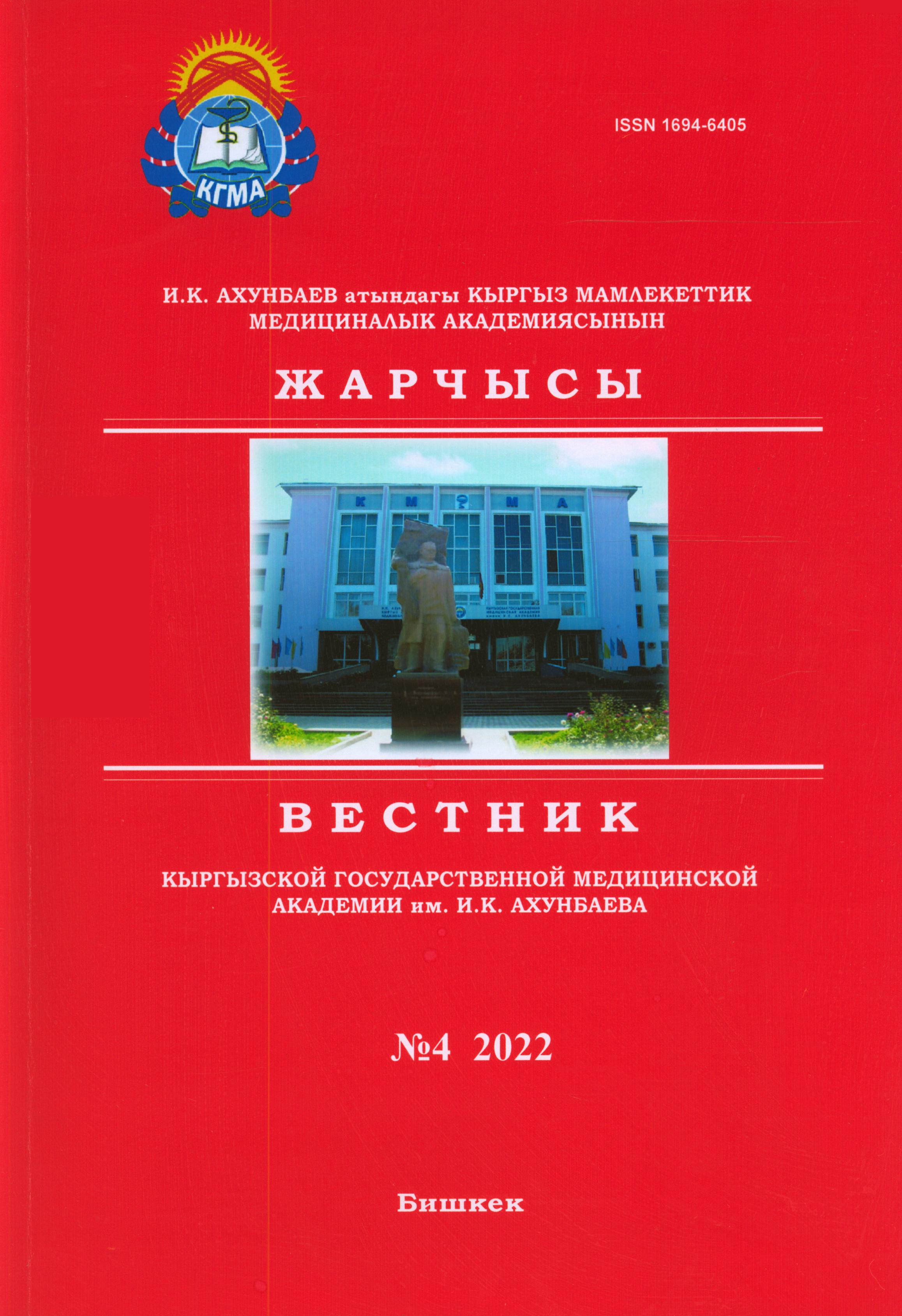ESTIMATED CONSUMPTION OF ANTIBIOTICS AT THE HOSPITAL LEVEL IN THE KYRGYZ REPUBLIC
DOI:
https://doi.org/10.54890/1694-6405_2022_4_19Abstract
Abstract. Improving the quality of antibiotic use in hospitals is one of the main goals of the World Health Organization (WHO) global action plan to combat antibiotic resistance. Drug use analysis provides insight into clinical use, comparisons across countries, regions and health system settings, and changes in drug use over time. The purpose: was to analyze the consumption of antibiotics using DDD analysis in a multidisciplinary hospital in Bishkek, the Kyrgyz Republic for the period 2016-2019. Materials and research methods. To assess the level of consumption of antibiotics, the WHO-recommended system of “conditional daily doses” (Defined Daily Dose, DDDs) and DDDs per 100 bed-days (DDDh) were used. Results. Consumption and purchases are 8 groups of antibiotics - penicillins, cephalosporins, macrolides, fluoroquinolones, nitroimidazoles, aminoglycosides, carbapenems and glycopeptides. Discussion. During the study period, there is a trend of increased consumption of cephalosporins I, IV generations, penicillins, fluoroquinolones, aminoglycosides, carbapenems and glycopeptides. There is a decrease in the consumption of cephalosporins II, III generations, macrolides, aminoglycosides, nitroimidazoles. The use of the lincosamide group, nitrofurantoin, tetracyclines were limited only in 2017 or 2018. Conclusions. The structure of consumption in a multidisciplinary hospital was dominated by IV generation cephalosporins, fluoroquinolones, carbapenems, glycopeptides, aminoglycosides (mainly amikacin), the widespread use of which can contribute to the formation of microorganisms with multiple resistance. In 2016-2019 there is a positive trend in the consumption of the group of penicillins, cephalosporins of the first generation, nitroimidazoles, nitrofurantoin. An increase in the consumption of levofloxacin by 5.6 times and moxifloxacin by 10 times requires an assessment of their rational use. Revealed positive changes in the consumption of macrolides, which have limited indications for use at the hospital stage.
Keywords:
antibacterial drugs, antibiotic consumption analysis, management system, quality of antibiotic use, ATC/DDD methodology, World Health Organization.References
1. Hartzema AG, Porta MS, Tilson HH. Introduction to pharmacoepidemiology. Drug Intell. Clin Pharm. 1987;21:739-740.
2. Гомон Ю.М., Курылев А.А., Колбин А.С., Проскурин М.А., Иванов И.Г., Сидоренко С.В. и др. Анализ потребления антибактериальных препаратов для системного применения в стационарах г. Санкт-Петербург в 2014-2015 гг. Журнал Инфектологии. 2018;10(3):115-123. https://doi.org/10.22625/2072-6732-2018-10-3-115-123
3. Гомон Ю.М., Колбин А.С., Светличная Ю.С., Проскурин М.А. Комплексная оценка потребления антимикробных препаратов на стационарном этапе оказания медицинской помощи в Санкт-Петербурге в 2014-2016 гг. Медицинские технологии. Оценка и выбор. 2018;4:39-46. https://doi.org/10.31556/2219-0678.2018.34.4.039-046
4. Hsia Y, Lee BR, Versporten A, Yang Y, Bielicki J, Jackson C, PhD et al. Use of the WHO Access, Watch, and Reserve classification to define patterns of hospital antibiotic use (AWaRe): an analysis of paediatric survey data from 56 countries. The Lancet. 2019;7(7):е861-е871. https://doi.org/10.1016/S2214-109X(19)30071-3
5. Roberts SC, Zembower TR. Global increases in antibiotic consumption: a concerning trend for WHO targets. Lancet. 2020; 11(1):10-11. https://doi.org/10.1016/S1473-3099(20)30456-4
6. Kleina EY, Van Boeckeld ThP, Martineza EM., Panta S, Gandraa S, Levine SA. et al. Global increase and geographic convergence in antibiotic consumption between 2000 and 2015. PNAS. 2018;115(15):E3463–E3470. https://doi.org/10.1073/pnas.1717295115
7. Sriram A, Kalanxhi E, Kapoor G, Craig J, Balasubramanian R, Brar S et al. The State of the World's Antibiotics in 2021. A Global Analysis of Antimicrobial Resistance and Its Drivers. Washington: The Center for Disease Dynamics, Economics & Policy (CDDEP), Inc.; 2021. Available from: https://onehealthtrust.org/wp-content/uploads/2021/02/The-State-of-the-Worlds-Antibiotics-in-2021.pdf
8. Global Essential Medicines [Internet]. Toronto: University of Toronto; 2019. Available from: https://global.essentialmeds.org/dashboard/countries/64
9. 7th meeting report of WHO advisory group on integrated surveillance of antimicrobial resistance (AGISAR). Geneva: World Health Organization; 2018. Available from: https://apps.who.int/iris/bitstream/handle/10665/272714/WHO-NMH-FOS-FZD-18.1-eng.pdf
10. WHO Model List of Essential Medicines: WHO AWaRe Classification Database of Antibiotics. Date: 2019, Date accessed: April 17, 2020. Available from: https://www.who.int/news/item/01-10-2019-who-releases-the-2019-aware-classification-antibiotics
11. Klein EY, Milkowska-Shibata M., Tseng KK, Sharland M, Gandra S, Pulcini C et al. Assessment of WHO antibiotic consumption and access targets in 76 countries, 2000–15: an analysis of pharmaceutical sales data. Lancet Infect Dis. 2020;21(1):107-115. https://doi.org/10.1016/S1473-3099(20)30332-7
12. IQVIA. IQVIA MIDAS. 2000-2015. Available from: https://www.iqvia.com/solutions/ Commercialization/ geographies /midas
13. ДЛСиМИ. Перечень жизненно-важных лекарственных средств КР, ПП КР №274 от 06.06.2018. Режим доступа: http://www.pharm.kg/ru/live_important/
14. WHO Collaborating Centre for Drug Statistics Methodology. ATC/DDD Index. 2017. Available from: https://www.whocc.no/atc_ddd_index/
15. Зиганшина Л.Е., Магсумова Д.Р., Кучаева А.В., Пикуза О.И., Герасимов В.Б., Яворский А.Н. АТС/DDD - классификационная система в фармакоэпидемиологических исследованиях. Качественная клиническая практика. 2004;1:28-33.







